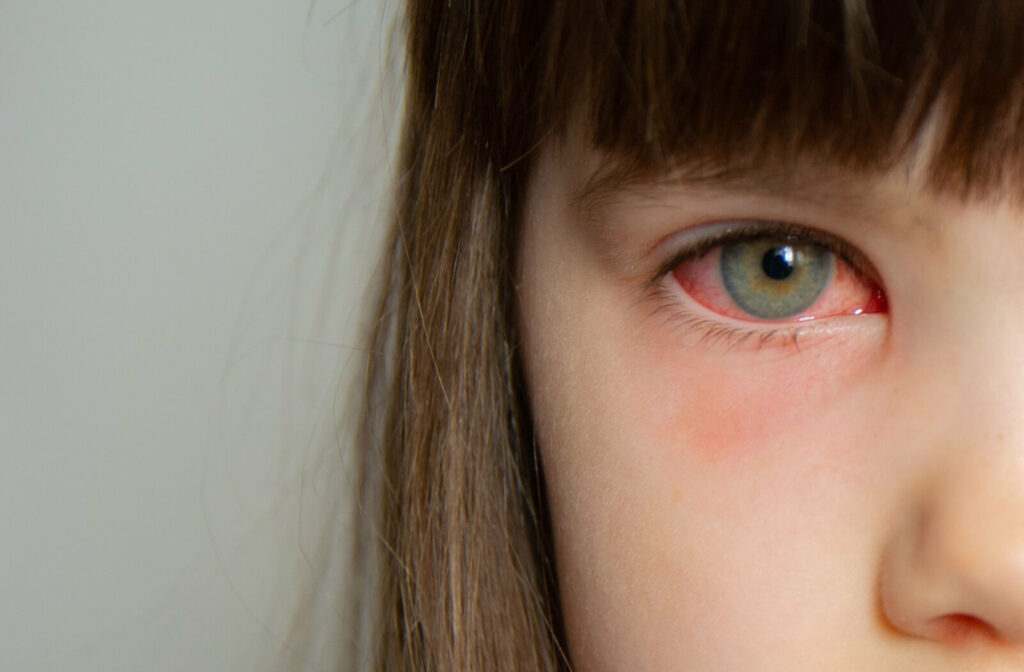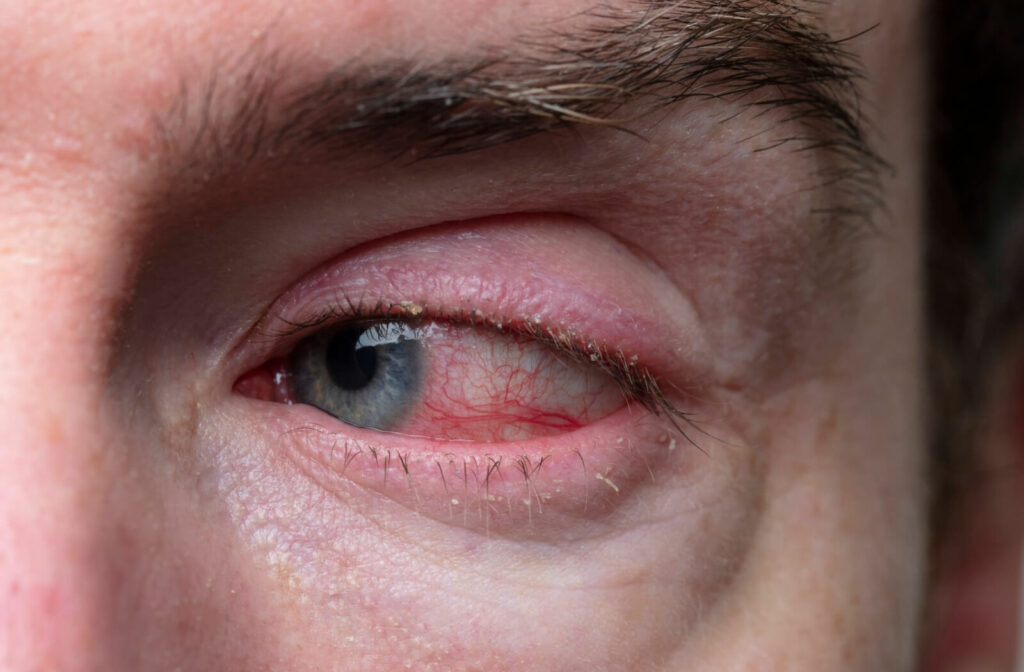Blepharitis and pink eye are two infections with symptoms that typically cause eye discomfort and redness. Due to many similarities, some people have difficulty determining which infection they are experiencing.
Blepharitis is an inflammation of the eyelid, while pink eye is an infection of the conjunctiva. Please read the full blog below to learn more about their differences and some potential treatment plans.
Whether you’re experiencing an eye infection, eye emergency, or are simply looking to keep your prescription up to date, our friendly doctors at Griffin Optometric Group are here to support your visual health.
What’s the Difference Between Blepharitis and Pink Eye?
Blepharitis generally affects the eyelid, which folds over your eye to protect it. In contrast, pink eye affects the conjunctiva, the lining of the inside of your eyelid, protecting it by producing mucus and tears. The other key difference is that pink eye occurs in the blood vessels, and blepharitis develops in the oil glands.
What Is Blepharitis?
Blepharitis is a common eye infection that is not contagious but can cause some eye discomfort. It typically develops due to clogging of the oil glands near the base of your eyelids which can lead to some inflammation. It can sometimes be difficult to treat but rarely results in any permanent damage to your eyes.
Symptoms of Blepharitis
The symptoms of blepharitis can be irritating and are usually more intense during the morning. Here are a few of the common symptoms you may experience:
- Watery, swollen, and red eyes
- Itchy or burning sensation in the eyes and eyelids
- Flaking skin or crusted eyelashes
- Higher sensitivity to light and blurry vision
In some cases, blepharitis may lead to more serious symptoms or complications like swelling in parts of the eye or a loss of eyelashes. Contact your doctor if you are experiencing any eye symptoms or discomfort.
How to Treat Blepharitis
There is no cure for blepharitis, but some techniques can be used to minimize discomfort and speed up the healing process.
- Warm compresses: To do this, soak a washcloth with warm water and place it over your eyes for at least a minute to help loosen flakes and ease discomfort.
- Antibiotics: An ophthalmologist may recommend using antibiotics to help reduce symptoms. It will typically be in the form of an ointment or oral pill.
- Eye Drops: Artificial tears can help to reduce the redness and discomfort in your eyes.
- Daily Hygiene Care: Keep your skin, eyelashes, and hair clean with safe shampoo products and water.
What Causes Blepharitis?
Blepharitis typically results from one of the following factors:
- Make-up overuse and not removing it before bed
- Ocular rosacea
- Seasonal allergies
- Poor hygiene
- Dry eyes
Tips to Avoid Blepharitis
Blepharitis can be caused in several ways, but with some preventative measures, you can reduce the risk of contracting the infection.
- Keep your eyelids clean and maintain proper hygienic practices
- Remove any eye makeup before going to sleep or stop using eye makeup if you are experiencing symptoms
- Consistently replace and clean items that are being used near your eyes and eyelids

What Is Pink Eye?
Conjunctivitis, otherwise known as pink eye, is a viral infection that generally happens through bacteria entering the eye or an allergic reaction.
Pink eye is contagious and can cause discomfort to your eyes, but it rarely results in any long-term problems.
Symptoms of Pink Eye
Here are some of the more common symptoms that people experience due to pink eye:
- Redness and swelling
- Yellow discharge that can accumulate over the eyelashes and eyelids
- Green or white discharge
- Itchiness or burning sensation in the eye
- Blurry vision and sensitivity to light
How to Treat Pink Eye
The cause of pink eye will affect how your doctor treats it. Here are a few of the common ways that pink eye occurs and is resolved:
- Bacteria: Your doctor may prescribe antibiotics to help resolve pink eye caused by bacteria.
- Virus: Pink eye caused by a virus may not require any treatment, but it is best to consult a doctor.
- Allergies: Anti-inflammatory drugs or eyedrops may be prescribed to help resolve pink eye caused by allergies.
- Chemical splash or foreign object in the eye: Your eye doctor may be able to resolve this by flushing the eye and cleaning it.
Tips to Avoid Pink Eye
Pink eye can be very contagious, so it’s important to protect yourself and do what you can to prevent contracting the infection:
- Avoid touching your eyes, particularly if your hands are unclean.
- Avoid sharing personal items that come in contact with your eyes.
- Properly store and clean your contact lenses.
Key Differences Between Blepharitis and Pink Eye
While both blepharitis and pink eye (conjunctivitis) cause eye redness and discomfort, they are distinct conditions with key differences. Understanding these differences can help you identify which condition you’re dealing with.
Location of Inflammation
- Blepharitis: The inflammation in blepharitis is centered around the eyelids, particularly at the base of the eyelashes. The edges of the eyelids become swollen and irritated, but the white part of the eye itself may not be as red.
- Pink Eye: Pink eye affects the conjunctiva, which is the thin, transparent membrane that lines the white part of the eye and the inside of the eyelids. This causes the entire eye to appear bloodshot and swollen.
Type of Discharge
- Blepharitis: The discharge in blepharitis is more about flaky debris or dandruff-like scales around the eyelashes. There is generally less liquid discharge, although the eyes can feel dry or gritty.
- Pink Eye: With pink eye, the discharge varies based on the cause. Viral conjunctivitis typically produces a watery discharge, while bacterial conjunctivitis leads to a thicker, yellow or green discharge that can cause the eyes to stick together, especially after sleeping.
Redness
- Blepharitis: Redness in blepharitis is primarily seen around the eyelids rather than in the white part of the eye itself. The eyelid margins may appear inflamed or swollen.
- Pink Eye: In pink eye, the entire eye can appear red, particularly the white part (sclera). This widespread redness is often more noticeable than the localized redness seen in blepharitis.
Itching and Irritation
- Blepharitis: Itching in blepharitis is usually felt more along the eyelid margins, with a gritty or burning sensation being more prominent in the eyes.
- Pink Eye: While pink eye can also cause itching, the irritation is more generalized across the entire eye. The itching can be intense, particularly in allergic conjunctivitis.
How We Can Help
If you’re having trouble identifying whether your infection is blepharitis or pink eye, don’t hesitate to book an appointment at Griffin Optometric Group. Our experienced team will be happy to discuss the services we can provide and alternative treatment methods to help you regain comfortable, clear vision.



